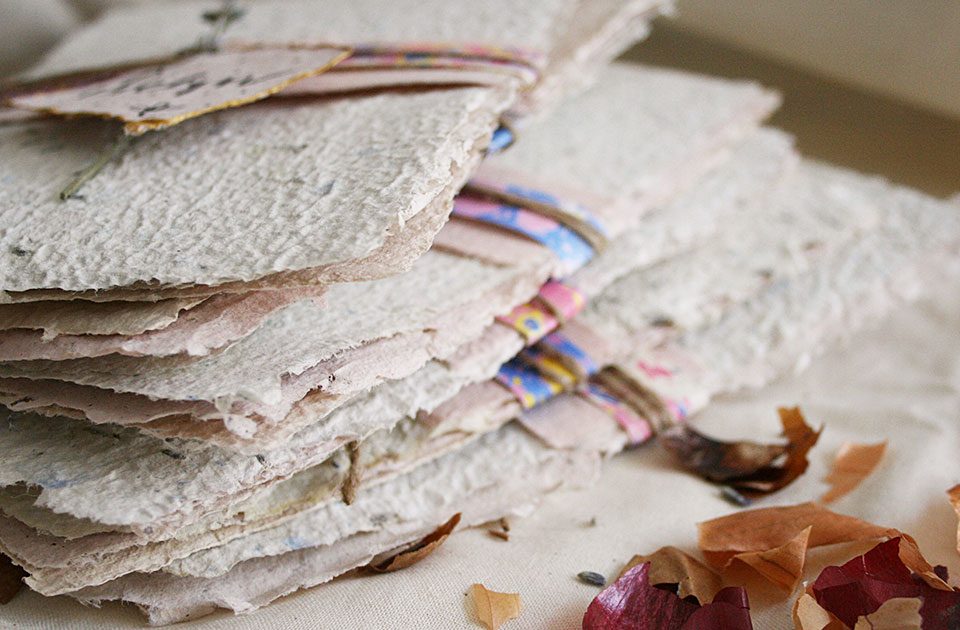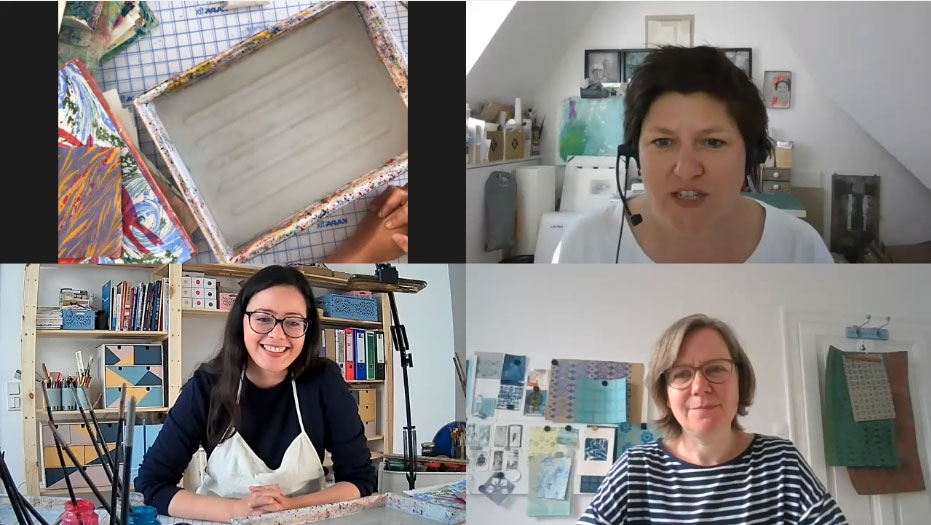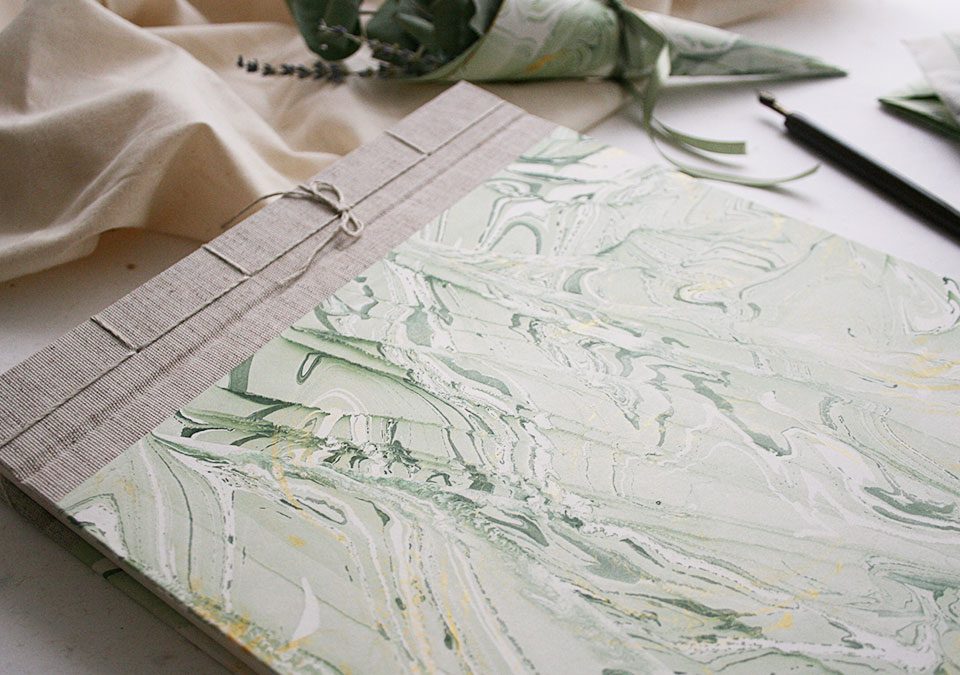
Happy Customers, Happy Craft Room
26/05/2020
The Indigo Bookbinding Challenge
11/08/2020Finding the right paper for marbling shouldn’t be a problem. But there is such a huge offer out there, and sometimes we don’t have the time or the money to try them all out. The selection of paper for marbling will depend on the final use you want to give to the paper itself. For instance, I work with a range of quality art papers suitable for bookbinding projects, since I use my very own hand-marbled papers for binding Japanese notebooks and photo albums.
However, you can use regular paper for marbling, too. If you just want to have fun and spend a creative afternoon marbling paper, you don’t need a big budget for paper supplies. Copy and print paper works most of the time, too. This kind of paper might not be suitable for quality bookbinding projects, but it’s more than enough for easy-peasy crafts like handmade cards.
When choosing a paper for your DIY marbling project, you should keep a couple of things in mind:
- Avoid shiny papers, preferably use uncoated papers, since this helps the paints to stick to the paper easily
- Use papers that are between 90 gsm – 120 gsm. You can use thinner or thicker paper, but then you might run into problems when laying down the paper onto the marbling bath: thick paper is very stiff, making it hard to lay down and thin paper might break while doing so
- If you choose a coloured paper, take into consideration that the colours of the marbling paints will look different as if they were applied onto a plain white paper
I highly recommend testing as many papers as you can – if you have the chance. This is not just fun, but you will learn a lot in the process and you can create your very own collection of hand-marbled papers! Plus, you never know which paper might surprise you.
I have been testing different papers for my DIY Paper Marbling Kits since the very first day. It was interesting to see how the paint and the colours changed from one paper to another. I still have my favourite papers, though. And I want to share my top 5 papers for marbling with you!
Top 5 Papers for Marbling: A Mix of New & Old
Next time you are in your favourite art supplies store or looking around on the internet for new craft supplies, check if they have the following papers in their catalogue. I use to work with a range of quality art papers from well-known brands like Hahnemühle, Fabriano or Canson. All well-sorted art supplies stores should have some papers from these brands in their offer, and if you cannot find the exact kind of paper, ask for some help or look for a similar paper within the same brand.
Ok, here we go with my favourite top 5 papers for marbling!
#1: Hahnemühle Mould-Made Bookend & Cover Paper
This paper is frequently used as endpapers for books, but also for covers. It has a slight texture, which is very common in many papers from the same brand. Hahnemühle Mould-Made Bookend & Cover Paper is 100 gsm thick and it comes in two different colours, ivory and white. I use the ivory version, which is a little bit yellowish, giving the final papers a “vintage” look sometimes.
When using DEKA Marble Paints, you can choose whether to mordant this paper or not. I usually mordant this paper before marbling it, because the paint sticks better and the colours look more solid.
As the name indicates, this paper is suitable for folding covers. Once I have hand-marbled the paper, I use it for binding the covers of my Japanese notebooks or my Origami pop-up books. This is also the paper included in all DIY Origami Bookbinding Kits.
Hahnemühle Mould-Made Bookend & Cover Paper is usually sold in bigger packs and large format, but in my shop, you can find a cut-to-size version of this paper, ready to use for marbling! Click here for more information.
Here you can watch a paper marbling demo using DEKA Marble Paints and Hahnemühle Mould-Made Bookend & Cover Paper. All these products are included in my DIY Paper Marbling Kit, the easiest way to get started into the world of marbling!
#2: Sumi-e Japanese Paper
Many times I have heard the question: can you marble Japanese paper? And the answer is: yes! Now, I have just tried this using DEKA Marble Paints, so if you are using other brands, make a test first to see the results.
Sumi-e paper is also very easy to find in art supplies stores. I tested the paper from Hahnemühle, they sell blocks of Sumi-e paper in different formats and sizes. This Japanese paper is commonly used for calligraphy, but you’re free to give it other uses, of course.
This paper is thinner than the regular one, about 80 gsm. And pretty translucent, so not always suitable for bookbinding projects. Yet, Sumi-e paper is, in my opinion, a strong paper, I have used for hand-dyeing with Shibori and indigo and even after submerging the paper for minutes in a bucket filled with water, the paper kept its structure. So give it a chance, if you can!
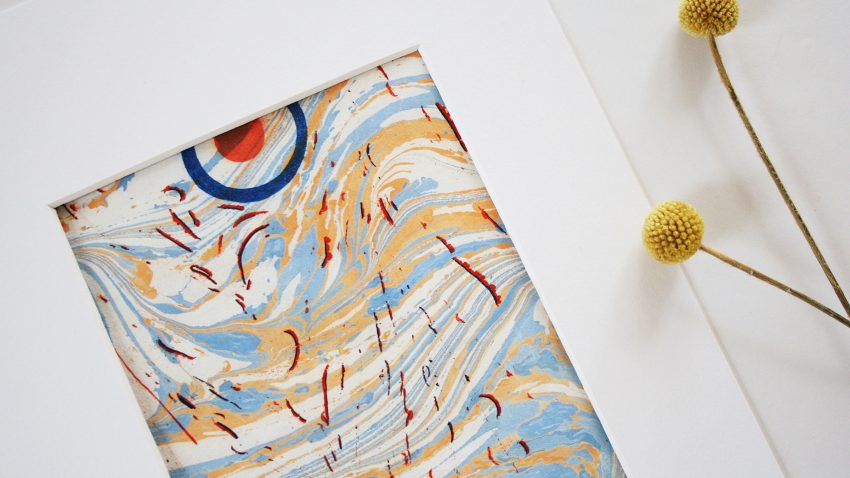
#3: Canson Mi-Teintes
Ok, I recommended at the beginning using paper from 90 gsm to 120 gsm. And so far I have listed a paper which is 80 gsm, and I am about to list a paper that is 160 gsm… Anyhow, if you want to try a paper that is a little bit thicker, has a strong texture and is available in dozens of colours… then you have to try Canson Mi-Teintes!
Some makers use this paper as endpapers for books, too. I tried it but it was too thick for my taste. However, Canson Mi-Teintes can be a great paper for quality handmade cards and steady posters.
This paper has a few downsides, however: first, since the paper is really thick, you might have trouble to flatten it, after marbling. So, make sure you place it under a pile of heavy books for a couple of days! Secondly, if you try to mordant the paper with a solution of alum and water, it might be possible that some of the paper’s own colour washes off – so I recommend to not mordant it.
#4: Copy/Print Paper Hema & Fabriano
As I mentioned above in the intro, you can also use regular copy and print paper for marbling. The quality of the paper won’t be as good as from an artist paper, but it might be enough for crafting some greeting cards or jazzing up your scrapbook projects.
I tested the copy/print paper from Hema, which is 75 gsm and pretty cheap. The results were surprisingly good. You can either mordant the paper before marbling or leave it as-is. The mordant might help the colours to stick better to the paper and show up a little bit brighter.
A more quality alternative to the cheap copy/print paper from Hema is Fabriano Copy Bio. This is an ecological, totally chlorine-free paper from the well-known Italian brand Fabriano. The paper is light-cream and less translucent than a typical print paper. You can make beautiful pocket notebooks with this paper!
#5: Old Atlas, Maps & Books
Probably the cheapest and most environment-friendly option. I have marbled dozens of sheets from old atlas books and maps. As long as the paper is uncoated, and doesn’t have a shiny appearance, it should be suitable for marbling.
Most of the times I don’t even mordant the paper before marbling it. But again, only when using DEKA Marble Paints. If you are using other paints, do a test first!
Using vintage atlases and maps for paper marbling has an extra “something”. You can create astonishing marbling patterns that highlight the singularities of the map itself.
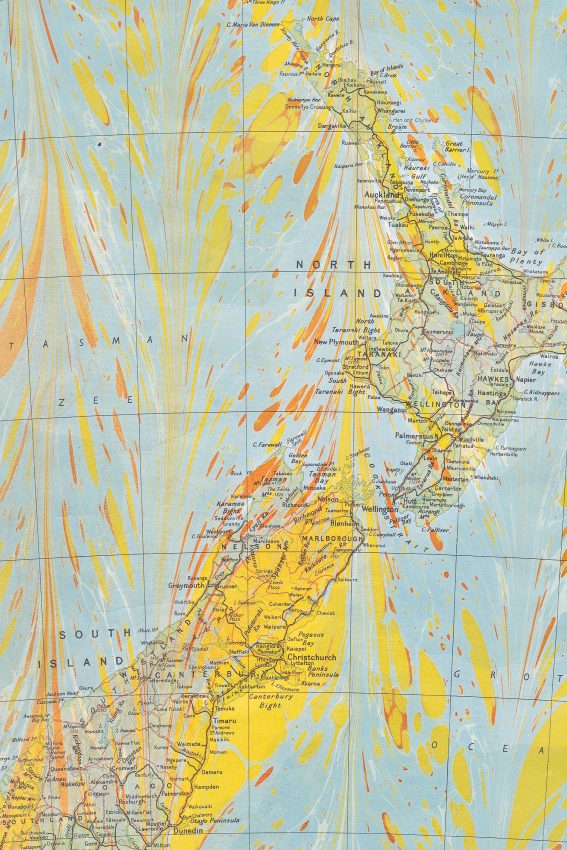
Don’t limit yourself: try out other kinds of papers like old books, postcards or even receipts! Go treasure hunting on a flea market or a thrift shop: they usually have tons of old books, maps and postcards that can make pretty good and cheap sources of paper for your next marbling project at home!
Remember that the thickness, texture and colour of the paper, as well as the technique or marbling paint brand you use, will determine what your marbling papers look like at the end. No matter which paper, technique or brand you go for: have fun and enjoy the colourful and relaxing journey of marbling!
Do you want to learn more about marbling? Join my exclusive community on Patreon and enjoy behind the scenes, special tips & tricks, webinars and more!
Your crafty fellow,
Karen



